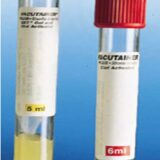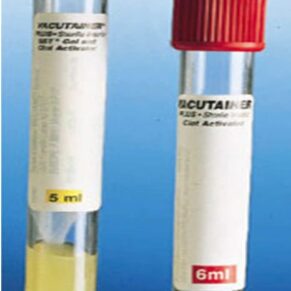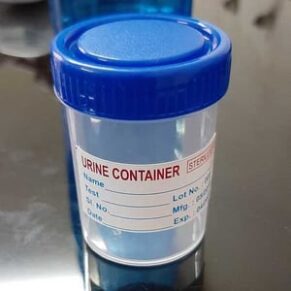- Your cart is empty
- Continue shopping
Shop
TYPHIDOT IGG + IGM
Typhidot test to detect IgG & IgM antibodies
Typhidot Test
The Typhidot test is a rapid serological test that assists medical professionals in diagnosing typhoid fever. A bacterium called Salmonella Typhi causes this fever. When this bacterium enters your body, your immune system releases two types of antibodies, IgG and IgM, to fight against the bacteria. Typhidot test is a ready-to-use dot ELISA kit designed for qualitative detection and differentiation of these antibodies separately against the outer membrane protein (OMP) of the Salmonella Typhi bacterium.
Typhoid is one of the most prevalent diseases in Indian settings. The fever spreads through contaminated food, drinks, and drinking water. It is a life-threatening illness that needs rapid diagnosis to ensure appropriate treatment of potential carriers and prevent Typhoid outbreaks.
Most of the detection methods fail to show accurate results. To confirm the presence of the bacteria, many patients are required to undergo ELISAs (enzyme-linked immunosorbent assays) and other blood cultures several times. Another diagnostic measure is bone marrow culture. But, it is too invasive and cannot be performed in a laboratory setting. In this respect, the typhidot test has proved to be an extremely valuable diagnostic tool.
What is the Typhidot test used for?
Doctors routinely order a Typhidot test to evaluate people who exhibit the following symptoms:
- Fever with body pain, especially in the head and legs
- Increased weakness and sleepiness
- Gradual increase in body temperature
- Bloating sensation
- Stomach pain
- Diarrhea
- Loss of appetite
- Cough
- Slow pulse rate in comparison to increasing body temperature
- Gastroenteritis (inflammation of intestines)
- The appearance of small red boils or rash on the back or in the abdominal area after a week of fever
- Malaise (a feeling of discomfort, weakness, loss of interest in any activities)
In some extreme cases, typhoid fever may also be accompanied by:
- Abnormal heart rate
- Excessive sweating
- Intestinal hemorrhage
- Enlarged liver and spleen
- Distended abdomen (abnormally swollen abdomen)
When should you contact a doctor?
Get in touch with a doctor if you have any of the following:
- Have visited an area where people are suffering from typhoid fever, and you have developed the symptoms
- Have been exposed to a person who has typhoid fever
- Have symptoms like reduced urine output, severe abdominal pain, and any other new symptoms
- Have suffered a recurrence of typhoid fever symptoms
What happens if typhoid fever is left undiagnosed?
Complete recovery from typhoid fever depends greatly on timely detection with the Typhidot test and accurate treatment. Delay in the same can lead to serious health complications. They can be:
- Kidney failure: Typhoid fever can cause acute renal failure and hepatitis, although these conditions are rare.
- Internal bleeding: If typhoid fever is not treated with appropriate antibiotics, it can cause internal bleeding. If the condition worsens, the patient may require a blood transfusion.
- Peritonitis: It is a very serious complication in which the bacteria infects your peritoneum (lining of your abdomen).
How do you prepare for a Typhidot IgM test?
There are no specific precautions or preparatory steps before this test. But remember to inform the doctor about any medications or health supplements that you take regularly. You may be asked to stop the intake for a few days before the test. Further, if you have any underlying medical condition, inform the doctor and the lab technician. Also, you do not need to fast before a Typhidot test.
What is the procedure of the Typhidot test?
A Typhidot IgM test is conducted in the following steps:
- An elastic band or tourniquet is tied firmly to your upper arm.
- You are asked to make a tight fist. As a result, the veins fill with blood, making it easier to collect the blood.
- Once the vein is located, the spot is cleaned using an antiseptic liquid. It stops any bacteria from entering your body.
- The needle is inserted into the vein, and the blood sample is collected in a vacutainer tube.
- The lab technician takes out the needle and releases the elastic band. You can then open your fist.
- A gauze pad or cotton is used to stop the bleeding.
- After this, the blood sample is placed on the Typhidot test kit and combined with the chemicals or reagents provided with the test kit.
- The test kit shows results within 1-3 hours.
Things to consider after a Typhidot test is complete
After the Typhidot test is completed, the needle is taken out gently. The needle insertion site is covered with cotton to stop the bleeding, and a bandage is applied. Initially, you may feel some pain, but it subsides in a few days.
There are no post-test restrictions associated with aTyphidot IgM test. You can resume your routine activities, eat, drink and move around. However, after receiving your test results, you must schedule an appointment with a doctor to discuss and understand if there are any concerns.





Customer reviews
Reviews
There are no reviews yet.
Write a customer review